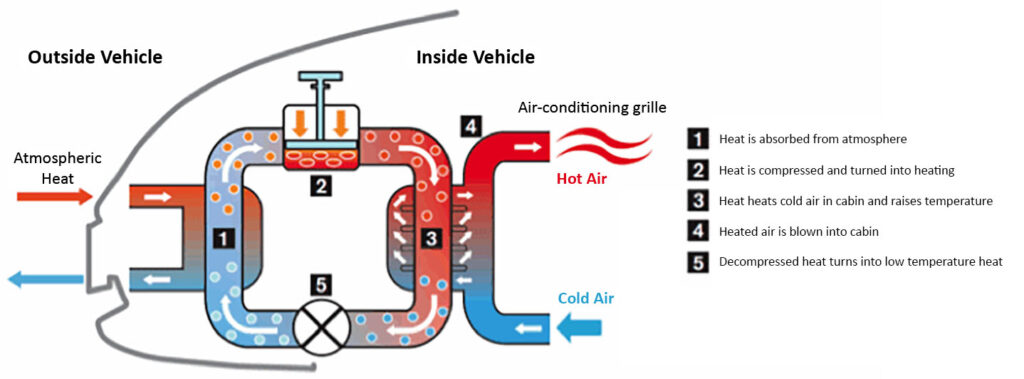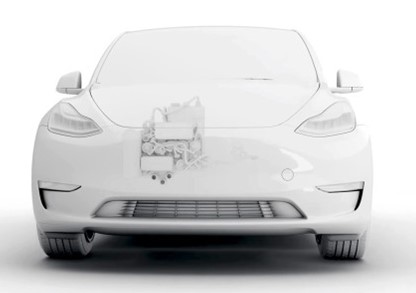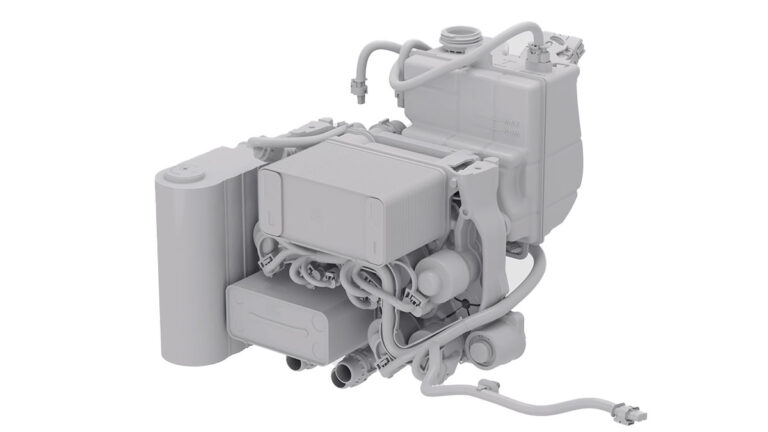Teslas and other electric vehicles don’t generate excess heat the same way ICE cars do. Not a lot of heat can be extracted from its motors or drivetrain as there is no combustion process taking place.
Until recently, Teslas relied on resistive heating to warm up the cabin and condition the battery packs to an optimum temperature. Resistive heating uses a lot of energy.
On the other hand, a heat pump can efficiently extract heat from the atmosphere or drivetrain components of the vehicle consuming a lot less energy than resistive heaters. How does a Tesla heat pump work?
How Does a Tesla Heat Pump Work?
In simple words, the Tesla heat pump system is an air conditioner that works in both directions.
It can draw heat from the atmosphere, and also heat generated in a Tesla’s drive unit, battery, electronics, and even the infotainment system and uses that heat to warm up the cabin or condition the battery pack.

The heat pump can scavenge heat from the atmosphere even in sub-zero temperatures. This ensures more efficient heating using much less energy than resistance heating in all weather conditions. A heat pump helps an EV retain as much driving range as possible in cold weather even when heating up the cabin.
What is a heat pump?
A heat pump is a system that can transfer heat from one place to another. It can be used both to cool or to heat a space depending on the direction the system is working in.
To heat a space, a heat pump transfers heat from the atmosphere and transfers it inside to make the space warmer. It can also cool a space by transferring heat from the space and releasing it into the atmosphere.
Heat pumps use much less energy than resistors as they move heat from one place to another instead of generating it. A heat pump can produce up to three times more heat than the power it consumes, making them ideal for electric vehicles.
Benefits of a Heat Pump in a Tesla
A Heat Pump Increases Driving Range in Cold Weather
One of the biggest drawbacks of driving electric vehicles in cold temperatures is the loss of range. Winter driving in a Tesla means more frequent recharges and increased range anxiety.
Batteries lose capacity when it’s cold outside, and batteries need to be kept at relatively warm temperatures for optimum power output. The thermal management system of the battery in a Tesla needs to use a lot of energy to heat up the battery pack and keep it within its operational temperature.
If the outside temperature is near freezing, it can reduce your driving range by 10-15%. Extreme cold conditions can reduce driving range by up to 30%.
Losses generated by cold weather can reduce your estimated 400 miles of range into 200 miles of range in real usage conditions.
This is where the Tesla heat pump comes in as it not only helps to warm the cabin but also manages to maintain optimum drive unit and battery temperature without using nearly as much energy as resistance heaters.
This means that your winter driving range could very well be extended by 10%, or even more if you use battery preconditioning when your Tesla is plugged in.
A Heat Pump Maximizes Supercharging Speed
Supercharging might seem fairly straightforward as it might seem it only takes plugging the car in for it to work its magic, but there’s a lot of science and calculations behind it.
Reaching maximum supercharging speed is difficult because the battery needs to be at an optimum temperature. The battery needs to be at a certain temperature at which it can take so much energy without causing any damage.
Whenever you plug your Tesla in, the energy management system needs to decide which kW output is the safest and quickest for charging up the battery according to its current temperature
Some cars will start at extremely high kW levels and work their way down while coming closer to a full charge while others will never reach their limits.
The heat pump can efficiently pre-condition the battery while you are driving toward a Tesla Supercharger.
Teslas equipped with a Heat pump will be able to maximize your Supercharging speeds as your battery wil be at its optimum charging temperature the moment you arrive at your charger without draining itself.
Do all Teslas Have a Heat Pump?
The first heat pump in a Tesla was introduced in the 2020 Tesla Model Y. Since 2021, the rest of the Tesla lineup has been equipped with a heat pump system. All Teslas are now equipped with a heat pump since mid-2021.

Pre-2021 models don’t come with a heat pump, and no plans exist to retrofit heat pumps into older models. Retrofitting a heat pump system into an older Tesla is an arduous task as the entire HVAC system will need to be reworked and new plumbing will need to be added.
Can you retrofit a Heat pump into older Teslas?
Retrofitting a heat pump system is an immensely difficult task as it requires you to replace the entire HVAC system of the vehicle.
Therefore, if you own an older Tesla without a heat pump, you’ll have to make do with resistance heaters which, in a vacuum, are more than good enough.
What Is So Special About the Tesla Heat Pump?
The reason Tesla’s heat pump is so special is that it was designed to be as simple and efficient as possible. A heat pump system can be implemented in many different ways, and it’s already used widely in residential and commercial buildings. Tesla
The Super Manifold combines many components into a simple piece
The “Super Manifold” is a simple two—piece PVC assembly that Tesla believes would otherwise need many separate components to work. Moreover, Tesla also integrated its own coolant loop which is also simpler and cheaper compared to most other systems out there.
All in all, all of these small changes and innovations lead to a fairly sizeable energy saving of up to 3-4 times less energy being used compared to a normal resistance heater.
Tesla took a well-developed and decades-old concept of a heat pump; then it built a newer, better version of it adapted to the needs of an electric car.
Read more: How do Tesla heaters work?

